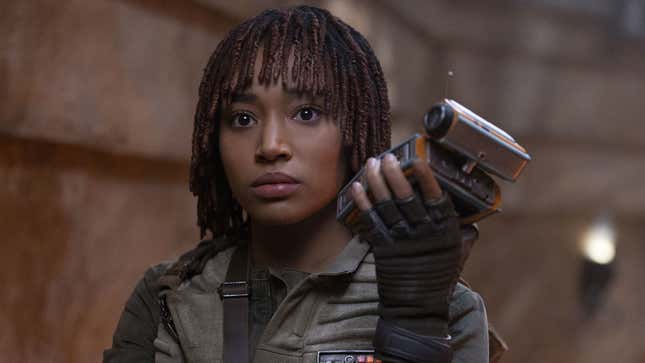Blame Modern TV For Star Wars: The Acolyte’s Cancellation

The Acolyte wasn’t perfect, but it did break new narrative ground in Star Wars, a franchise often haunted by Force ghosts and endlessly recurring characters. Led by Leslye Headland, the Disney+ series dared to reevaluate decades-old tropes, unpack the flaws of the Jedi Order, and play with the space sandbox setting in new, interesting ways. But The Acolyte, which starred Amandla Stenberg as twin sisters struggling to find balance in the Force and Manny Jacinto as a super-sexy baddie, was just officially canceled.
It won’t get a second season on Disney+, and right now the worst-behaved members of the Star Wars fandom are celebrating its demise. But while The Acolyte’s cancellation stokes the fires of that ongoing culture war, it’s also indicative of a much larger problem plaguing modern television—and streaming services and rising production costs are to blame.
The flaws of modern TV
The rise of a disparate (and expensive) collection of streaming services replacing the basic cable subscription for millions of paying customers has drastically changed the landscape of modern television. Back in the heyday of cable TV, there was far less time between seasons of a typical show than there is now. Look at Breaking Bad, widely considered one of the most prestigious of prestige television shows: The last episode of its first season aired in March 2008, while the first episode of the second season picked up almost exactly a year later. Now, there are routinely multiple years between seasons—two years elapsed before House of the Dragon season 2 followed its predecessor, nearly three years passed between seasons 2 and 3 of The Mandalorian, and the series finale of Stranger Things still doesn’t have a release window (the last season aired two years ago, and the next one just started production this year).
That is a massive amount of time for an invested audience to wait, and it can greatly diminish their enthusiasm for a series—it can also result in them literally losing the plot, as it’s difficult to remember what happened the previous season when it’s been several years since you last watched it. Plus, it’s tough to justify a second season when you know it’ll be in production for years—there’s no real reason to let a show breathe anymore, to let it iron out the first season’s kinks. If Parks and Recreation was canceled after season one, we’d have never gotten one of the funniest scenes in modern television.
Then there’s the cost of making prestige TV, which has skyrocketed in recent years. Amazon Prime’s Fallout series reportedly cost $153M for a single season. By the end of its run, Game of Thrones episodes required about $15M each for production after starting at around $6M an episode—and just a few years later, its spin-off House of the Dragon costs “less than $20m” per episode. With production costs so high, companies want a return on their investment, and they won’t take “it’s just the first season, let it cook” for an answer.
According to Forbes, estimates place The Acolyte’s cost of production at nearly $180M for just eight episodes, and its viewership was about half that of Ahsoka and 75% less than The Mandalorian’s. When companies are increasingly concerned with numbers going up, it’s impossible to justify another season of a series that’s so expensive to make when its viewership numbers don’t match other shows within the franchise—and therein lies our final problem: the franchise.
The Star Wars problem
In recent years, the only “successful” deviation from traditional Star Wars media has been Andor, the spy-thriller-esque series starring Diego Luna that’s a spin-off of 2016’s Rogue One. Despite it reportedly not having as large a viewership as The Mandalorian or Obi-Wan Kenobi, Andor’s second season is set to debut sometime in 2025. Though Andor technically retreads old ground like so many other Star Wars series, it feels incredibly fresh when compared to the other shows that rely so heavily on nostalgia to try and placate older fans. So it’s a welcome surprise that Disney decided to bankroll another season—especially since there are no plans for season two of either The Book of Boba Fett or Obi-Wan Kenobi.

But Andor is an exception, not the rule. A specific sect of fans are notoriously resistant to perceived changes to lore or the centering of marginalized folks in Star Wars media, and The Acolyte pissed them off from the jump: run by a woman, with a Black non-binary lead, lesbian witches, and a blistering take on the flaws of the Jedi, it became the focal point of a culture war before it even aired. Both Stenberg and Jacinto spoke out about the racist backlash The Acolyte faced, with the former even dropping a song that seems to reference the hate lobbed at them. At the time of writing, Stenberg’s latest Instagram post is filled with comments denigrating them: “Take the L never do Star Wars again,” reads one comment, while another asks, “How does it feel to have your terrible show canceled, princess?”
Unfortunately, in an age where modern television series are defined by their big price tags and (hopefully) bigger viewer numbers, a show like The Acolyte had an almost insurmountable feat in front of it in order to ensure its survival. If its mere existence hadn’t been used as the catalyst for conversations about “wokeism” in Star Wars, perhaps it would have had a fighting chance. But when a modern TV series takes place in a long-running franchise and dares to offer a different kind of fan-service, the sad reality is it will likely serve as a reminder of how far a fandom still has to go.
.
Source link




